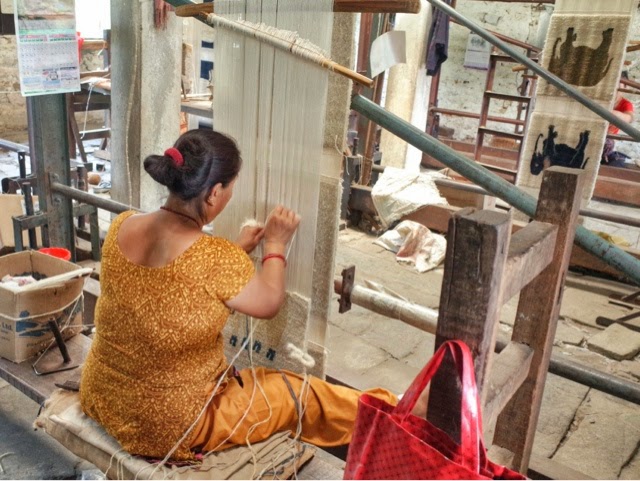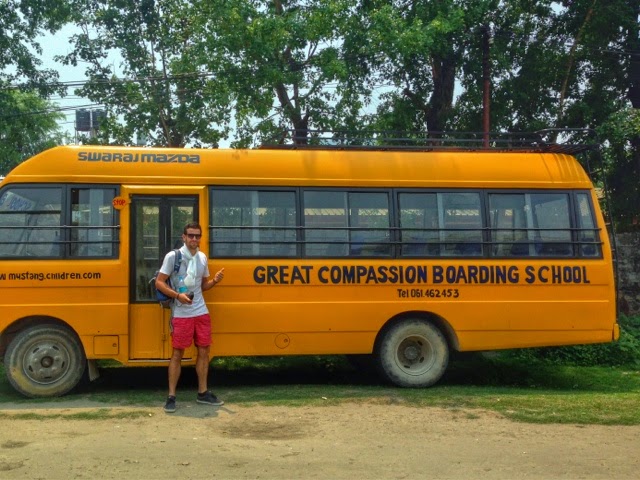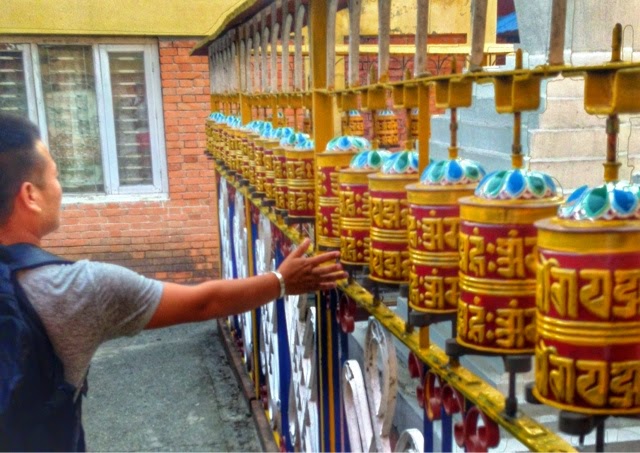I walked into the deserted classroom and saw the monk at the front, at his desk. He looked like a young Dali Lama. I walked toward him and noticed he was playing on an iPad (with an orange cover, matched his outfit.) I sat down and for 2-3 minutes he continued on the iPad.
He finally put the device aside, clasped his hands together and looked at me with confidence,
“So what do ya wanna know?”
I glanced at the tour guide and gathered my thoughts, out on a limb I blurted “why don’t monks get married?”
The monk put his right hand up, mimicking a scale that represented single life. His left hand was at a much lower level and it represented marriage.
“I have done the mathematics and ‘single’ is the best option. If I meet someone who changes my calculations, I will reconsider.”
I asked him about the school, life as a buddhist teacher and his iPad apps; he liked the calculator (nerd).
The monk invited me to his next lesson, on Buddhist philosophy. The class wasn’t with the children of the monastery, it was with western tourists. Half a dozen people were already waiting as I found my place on the mat and the monk took his place up the front, on a throne. He spent the first 5 minutes of the lesson disassociating himself and the throne, it made him feel ridiculous he said; then he discussed ‘absolute truths’ and how we are to perceive truth.
A British woman asked, or rather stated, “This bottle in my hand… is it really a bottle? how can we label it when in reality it is just plastic formed into a shape that holds water?”
My eyes were rolling like a bowling ball “Yes, but if I ask you to throw me the ‘bottle’ you will have little trouble understanding what I am referring to” the monk replied. My tour guide tugged my arm after a few minutes and suggested we move on, so we did.
Tibet
Tibetan culture captures the imagination and I think it is because I know very little about it. I have a vague image of a people living high in a plateau surrounded by nothing other than mountains with snow, dressed in robes and cut off from the world both by geography and politics.
China decided to crack down on the people of Tibet inside what they saw as territory belonging to themselves. In the 1950’s some Tibetans stayed to fight, some submitted to the might of the Chinese invaders and others escaped over the Himalayas to Nepal, a journey I can barely imagine.
Tibet has an average altitude of 4,900 meters and, if you make it, the walk to Nepal takes 10 days. The Tibetans who fled the turmoil arrived in Nepal where the Red Cross helped establish Tibetan settlements, they are essentially refugee camps and the Buddhist monastery I visited is inside one.
 |
| These are police recruits jogging along the road with guns. I took this photo on our way to the Tibetan hospital. |
The Doctor at The Tibetan Hospital
The doctor told me that every injury and illness results from the thought of injury and illness. I didn’t mention all the bones I’ve broken and I tried not to think about them either. I guess it is the thought that counts. I am a skeptical person and I was inside a hospital entirely devoted to the kind of medicine that invites incredulity. I asked more questions than a police officer, not for the sake of argument but to understand their ideas and how they deal with illness. By the end, the doctor seemed exhausted and told me that it was good to discuss medicine with “someone that knows a lot about it”…that is me, the guy who dropped out of school at 16 and has since nailed bits of wood together for a living.
 |
| This sign was outside the front of the hospital where I met the Tibetan doctor. |
 |
| I asked Thupten about this sign, he said Nepali people play against them here and start fights. |
| The iconic palace in Tibet. A carpet woven by the people of the settlement. |
 |
| Carpet weaving, the photo dose not show how quickly this woman was working. |
 |
| Woman at the carpet factory |
 |
| I’ve always felt great compassion for those forced to go to boarding school. |
 |
| The prayer wheels. written prayers are wrapped tightly within each and “the prayer is multiplied when you spin them” efficient.
I returned to the lakeside area of Pokhara feeling grateful, I’d been shown a community I didn’t know existed within Nepal. At times I almost felt I was intruding, but Thupten clearly had a lot of respect within the community and the people were very welcoming. The settlements seemed quite separate from Nepali society, they had entrances and fences, this after more than half a century. I guess I have too basic an understanding of Nepali society, how can I begin to picture the assimilation of various cultures within it?
Of course I realise this is only a snapshot of Tibetan culture and Tibet itself is firmly on my travel list.
If you are in Nepal and want to see the settlements for yourself here are the details:Tibetan Encounter |





Fascinating insight of the people you have met on a road less travelled. Your description of the monks remind us of the ones we met up in the golden triangle northern Thailand. Kevins grt grandparents visited Nepal for “rest and health restoration” during the days of the British Empire from Armritsar on the foothills of the Himalayas. We would love to travel there one day………….. Travel on young man…we love reading your travel blogs. Travel safe Scott xxxx
LikeLike
Fascinating insight of the people you have met on a road less travelled. Your description of the monks remind us of the ones we met up in the golden triangle northern Thailand. Kevins grt grandparents visited Nepal for “rest and health restoration” during the days of the British Empire from Armritsar on the foothills of the Himalayas. We would love to travel there one day………….. Travel on young man…we love reading your travel blogs. Travel safe Scott xxxx
LikeLike
Thanks Sheila, you'll have to go some time, so much to see in Nepal!
LikeLike
Thanks Sheila, you'll have to go some time, so much to see in Nepal!
LikeLike